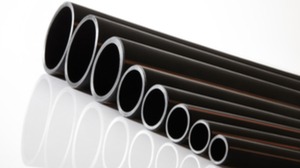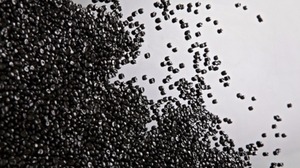Polypropylene is one of the most common plastics used worldwide. In fact, it’s second only to polyethylene in volume. Despite being such a commonly used material, however, it’s still important for engineers and entrepreneurs alike to understand polypropylene plastic: its properties, its uses and even a bit of its history. In addition to being broadly found in full-production manufacturing, polypropylene is well suited for prototyping. Understanding more about the material will help you learn why.
Some Background on Polypropylene
For such a ubiquitous material in manufacturing and packaging, polypropylene is relatively “young” — it was first synthesized in 1951. Yet it has had what might be called a meteoric rise to popularity, reaching a current global demand level of 55 million tons (based on recently available estimates). Amazingly, that demand is forecasted to continue to increase, with 5.8 percent growth predicted at least through 2021. Polypropylene use has not, so far, shown any signs of plateauing.
Polypropylene Properties
Why has polypropylene’s popularity grown, endured and even continued to grow? Its material properties make it extremely useful for a broad range of applications. It’s extremely easy to injection mold, thanks to good viscosity. It’s highly resistant to most other materials (like acids or bases), so it’s ideal for a broad variety of both consumer and industrial uses. It exhibits high levels of material strength, even in very thin gauge applications. As a thermoplastic material (as opposed to thermoset), it proves very cost effective due to the ability of excess or waste material to be reheated and recycled.
Polypropylene Uses
Those polypropylene properties, as mentioned, lend the material to a broad range of uses. Most often, you’ll find polypropylene used in packaging, whether for plastic “shells” for products, or thin plastic films. For those extremely thin-gauge films, especially, the high material and tensile strength of polypropylene make it well suited. Thanks to its versatility, polypropylene is also used in electronic components, automotive components, appliances and construction applications. One more area where polypropylene offers benefits is in prototyping, proving very useful for short-run injection molding and even CNC machining.
Polypropylene and Prototyping
 Perhaps it’s not surprising that a material with so many use cases, like polypropylene, is also extremely effective for prototyping. Before we get into the “why” and “how” about polypropylene for prototyping, let’s review the purposes that a prototype can (and should) serve. Remember that different prototypes and materials can fulfill different functions, so not every prototype iteration needs to satisfy all of the below factors at once.
Perhaps it’s not surprising that a material with so many use cases, like polypropylene, is also extremely effective for prototyping. Before we get into the “why” and “how” about polypropylene for prototyping, let’s review the purposes that a prototype can (and should) serve. Remember that different prototypes and materials can fulfill different functions, so not every prototype iteration needs to satisfy all of the below factors at once.
Functional testing: Prototyping should definitely be conducted to ensure that your product operates the way it should. If there are moving parts, for instance, they should move the right way (and not break or fall apart). As a strong, flexible material, polypropylene can approximate the characteristics of other strong materials to give you a good idea as to the proper functioning of your finished product.
Form and fit testing: If your product is a component that will be used in other applications, you need to be sure that, as designed, it will interact with other components and parts in the right way, and that it will fit correctly into an assembly (if applicable). Polypropylene has a relatively standard 2 percent shrinkage factor, so if your production material will be different, be sure to take that into account. Also note that polypropylene is not geared toward painting or dyeing (due to its low friction or “stickiness” down to the molecular level), so if your finished part will need to be painted, a polypropylene prototype will not be suitable for testing in that regard.
Aesthetic testing: If, on the other hand, your product does not need to be painted (and you are considering polypropylene as a production material), an aesthetic polypropylene prototype can give you a good idea of whether your part will look the way it’s supposed to (if that’s an important consideration).
Manufacturability testing: Can your product be correctly manufactured as designed? It’s a critical question, and one of the most important ones that prototyping can answer. Taking steps to prevent manufacturing defects or rejected parts is a critical use of prototyping.
How Can Polypropylene Help?
For prototyping purposes, polypropylene is suitable for two processes: CNC machining and injection molding. Although “polypropylene-like” materials exist for 3D printing and rapid prototyping, the polypropylene polymer itself is not ideal for (or readily available) formation into the filament required by those processes.
If you choose to prototype using CNC machining or injection molding, however, polypropylene is almost always a good choice. Let’s look at each method.
 Injection Molding
Injection Molding
Polypropylene’s good viscosity (as mentioned earlier), along with a relatively low melt temperature, make it ideal for efficient low-volume injection molding. With a very low friction coefficient, parts can be ejected from molds very easily, and cooling times are in line with other material standards.
Another key element of polypropylene is that, as a thermoplastic, residual material from injection lines, sprues and other areas of the process can be recovered, re-melted and used again for further prototyping. Over time, this recycling can make a tangible difference in your material costs. Depending on the purposes of your prototypes, they can even be fully melted themselves, freeing that volume of material for future iterations.
CNC Machining
Although polypropylene (and plastics in general) aren’t the first material that comes to mind when one considers CNC machining, it is possible to use PP for this process. In fact, it’s ideal for low-volume and prototype quantities where polypropylene is the material of choice, since it doesn’t require mold creation. Be sure to double check that your service provider has in fact CNC machined polypropylene before, since precautions are required to ensure that the process is carried out correctly.
As with injection molding, if you choose to, CNC machined polypropylene prototypes can be melted and re-used. Since CNC machining is a “reductive” manufacturing technique (meaning that material is removed to achieve the final form), it generates a good amount of waste — which can also be re-used.
Finally, polypropylene is often the material of choice for some (or all) prototypes of a product simply because it will also be the production material, and an identical prototype is desired or required. As you move your prototype through the cycle to becoming production-ready, polypropylene can end up being a key factor in your success.


 Injection Molding
Injection Molding
